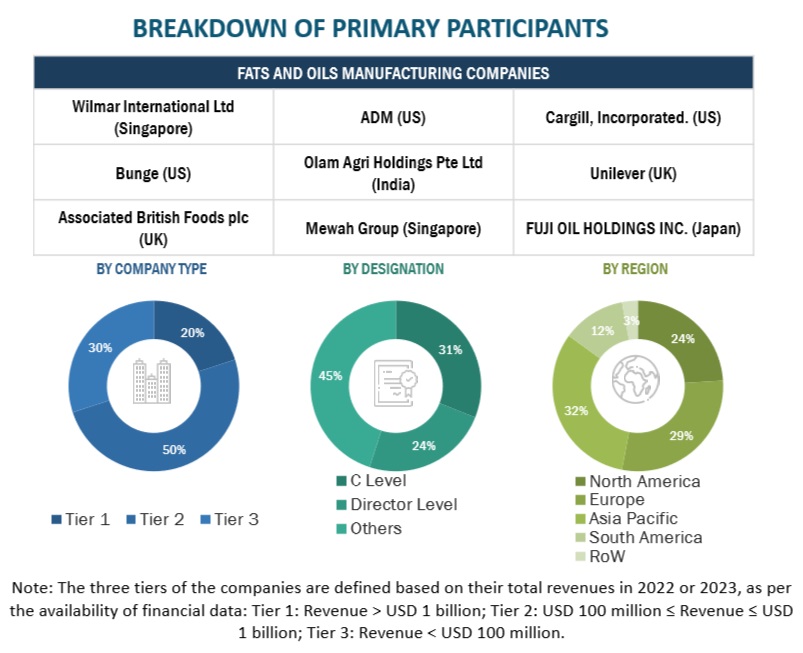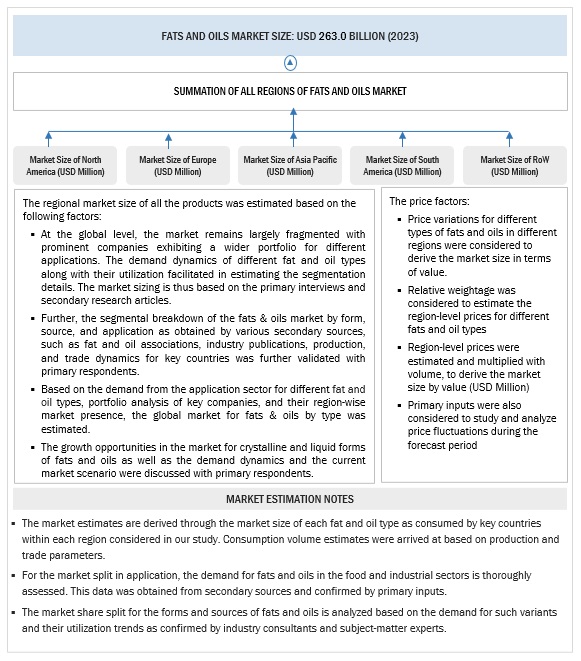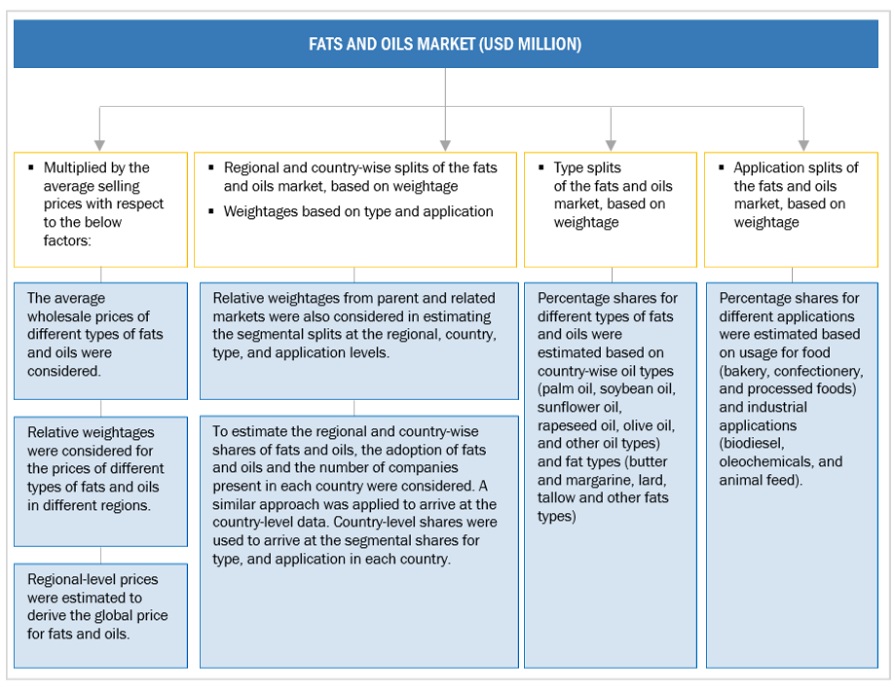The study involved major segments in estimating the current size of the fats and oils market. Exhaustive secondary research was done to collect information on the market, peer, and parent markets. The next step was to validate these findings, assumptions, and sizing with industry experts across the value chain through primary research. Both top-down and bottom-up approaches were employed to estimate the complete market size. After that, market breakdown and data triangulation were used to estimate the market size of segments and subsegments.
Secondary Research
This research study involved the extensive use of secondary sources—directories and databases such as Bloomberg Businessweek and Factiva—to identify and collect information useful for a technical, market-oriented, and commercial study of the fats and oils market.
In the secondary research process, various sources such as annual reports, press releases & investor presentations of companies, white papers, food journals, certified publications, articles from recognized authors, directories, and databases were referred to identify and collect information.
Secondary research was mainly used to obtain key information about the industry’s supply chain, the total pool of key players, and market classification and segmentation as per the industry trends to the bottom-most level, regional markets, and key developments from both market- and technology-oriented perspectives.
Primary Research
Extensive primary research was conducted after obtaining information regarding the fats and oils market scenario through secondary research. Several primary interviews were conducted with market experts from both the demand and supply sides across major countries of North America, Europe, Asia Pacific, South America, and the Rest of the World. Primary data was collected through questionnaires, emails, and telephonic interviews. The primary sources from the supply side included various industry experts, such as Chief X Officers (CXOs), Vice Presidents (VPs), Directors from business development, marketing, research, and development teams, and related key executives from distributors and key opinion leaders. Primary interviews were conducted to gather insights such as market statistics, data on revenue collected from the products, market breakdowns, market size estimations, market forecasting, and data triangulation. Primary research also helped in understanding the various trends related to fats and oils type, form, source, application, and region. Stakeholders from the demand side, such as food & beverage manufacturers who use fats and oils, were interviewed to understand the buyer’s perspective on the suppliers, products, and their current usage of fats and oils and the outlook of their business, which will affect the overall market.

To know about the assumptions considered for the study, download the pdf brochure
|
COMPANY NAME
|
designation
|
|
Wilmar International Ltd (Singapore)
|
Regional Sales Manager
|
|
Cargill, Incorporated. (US)
|
Marketing Manager
|
|
ADM (US)
|
General Manager
|
|
Bunge. (US)
|
Sales Manager
|
|
Olam Group (Singapore)
|
Sales Manager
|
|
Unilever (UK)
|
Sales Executive
|
Market Size Estimation
Both the top-down and bottom-up approaches were used to estimate and validate the total market size. These approaches were also used to estimate the size of various dependent submarkets. The research methodology used to estimate the market size includes the following:
-
The key players in the industry and markets were identified through extensive secondary research.
-
All shares, splits, and breakdowns were determined using secondary sources and verified through primary sources.
-
All possible parameters that affect the markets covered in this research study were accounted for, viewed in extensive detail, verified through primary research, and analyzed to obtain the final quantitative and qualitative data.
-
The research included the study of reports, reviews, and newsletters of top market players, along with extensive interviews for opinions from leaders, such as CEOs, directors, and marketing executives.
Global Fats and Oils Market: Bottom-Up Approach.

To know about the assumptions considered for the study, Request for Free Sample Report
Global Fats and oils Market: Top-Down Approach.

Data Triangulation
After arriving at the overall market size from the estimation process explained above, the total market was split into several segments and subsegments. To estimate the overall fats and oils market and arrive at the exact statistics for all segments and subsegments, data triangulation and market breakdown procedures were employed, wherever applicable. The data was triangulated by studying various factors and trends from the demand and supply sides. Along with this, the market size was validated using both the top-down and bottom-up approaches.
Market Definition
Fats & oils are simple or mixed glyceryl esters of various organic acids, which belong to the fatty acid series; they are derived from plant or animal sources. Fats belong to a group of compounds that are soluble in organic solvents but insoluble in water. Fats are available in either liquid (oil) or solid forms at room temperature.
Fats & oils are a group of organic substances widely used for various industrial applications. They are used as functional ingredients for manufacturing food products, such as confectionery, bakeries, and ice-creams, among others. Fats & oils play a major role in maintaining the physiochemical and sensory attributes, such as smoothness, creaminess, the texture of products, and greasy and thick consistency.
Key Stakeholders
-
Fat and oil manufacturers
-
Fat and oil importers and exporters
-
Fat and oil traders, distributors, and suppliers
-
Government and research organizations
-
Commercial research & development institutes
-
Raw material suppliers and distributors
-
Associations and industry bodies such as:
-
United States Department of Agriculture (USDA)
-
Food and Agriculture Organization (FAO)
-
American Fats and Oils Association (AFOA)
-
National Edible Oil Distributors Association (NEODA)
-
Institute of Shortening and Edible Oils (ISEO)
-
American Oil Chemists’ Society (AOCS)
-
Argentina Association of Fats and Oils (ASAGA)
Report Objectives
-
To define, segment, and forecast the global fats & oils market based on type, form, source, application, and region from 2020 to 2023 and a forecast period from 2024 to 2029
-
To provide detailed information about the key factors, including drivers, restraints, opportunities, and challenges influencing the growth of the market
-
To identify attractive opportunities in the market by determining the largest and fastest-growing segments across regions
-
To analyze the demand-side factors based on the following:
-
Impact of macro and microeconomic factors on the market
-
Shifts in demand patterns across different subsegments and regions
-
Strategically profile the key players and comprehensively analyze their core competencies
-
Competitive developments, such as partnerships, mergers & acquisitions, new product developments, and expansions & investments in the fats & oils market
Available Customizations:
With the given market data, MarketsandMarkets offers customizations according to company-specific scientific needs.
The following customization options are available for the report:
Product Analysis
-
Product Matrix, which gives a detailed comparison of the product portfolio of each company.
Geographic Analysis
With the given market data, MarketsandMarkets offers customizations according to company-specific scientific needs.
-
Further breakdown of the Rest of the European fats and oils market into key countries
-
Further breakdown of the Rest of Asia Pacific fats and oils market into key countries
-
Further breakdown of the South American fats and oils market into key countries
Company Information
-
Detailed analyses and profiling of additional market players (up to five)



Growth opportunities and latent adjacency in Fats & Oils Market